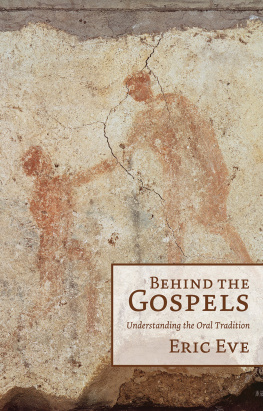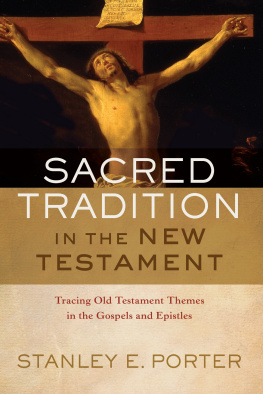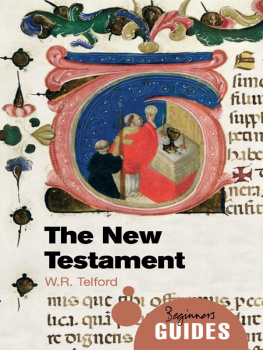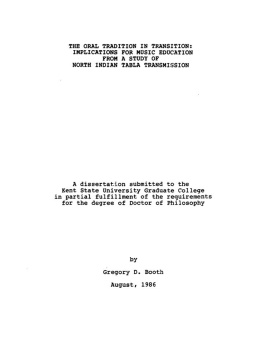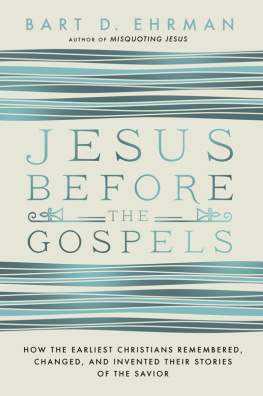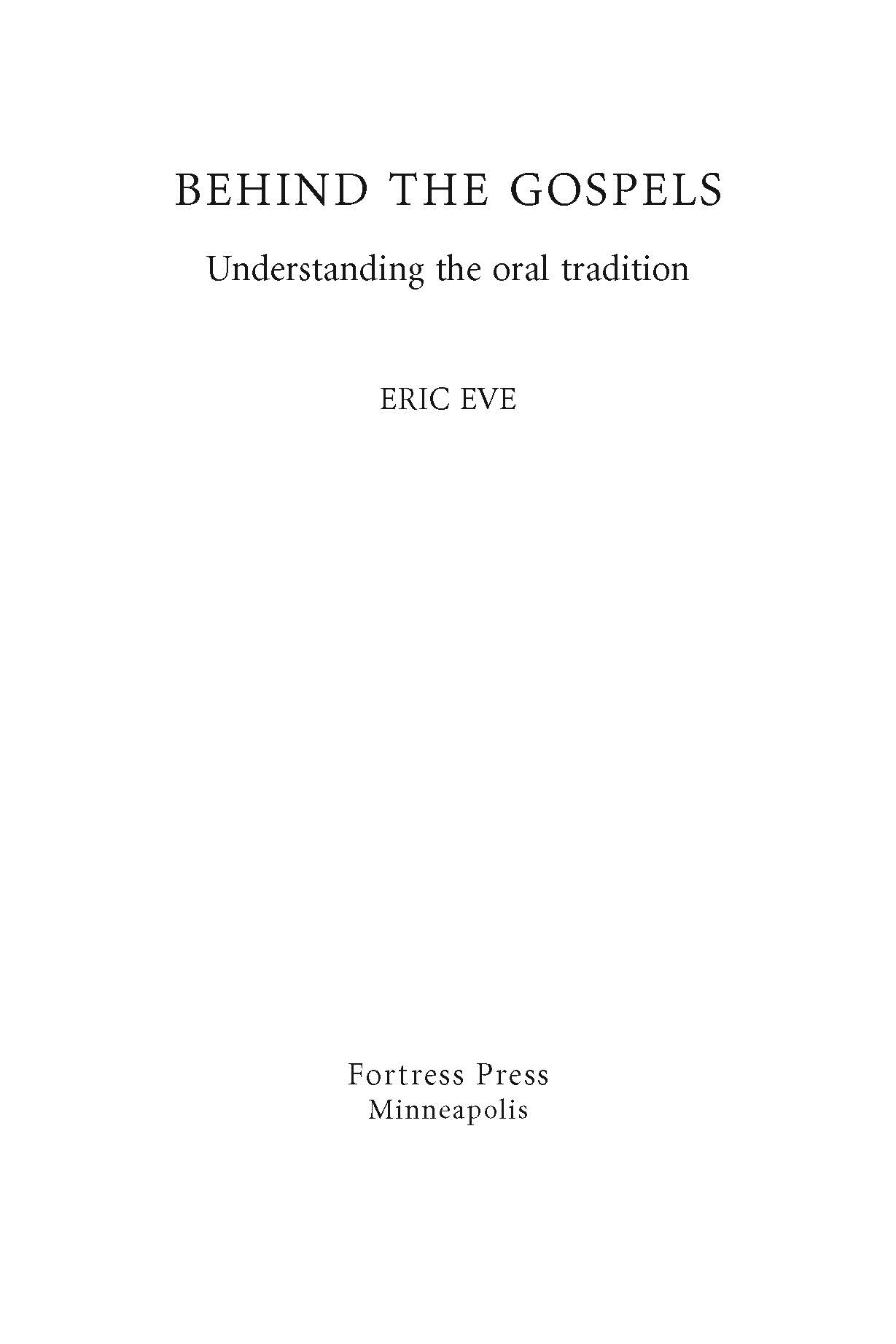Eric Eve is Fellow and Tutor in Theology at Harris Manchester College, Oxford. He has published a number of articles and other short pieces on various aspects of the Gospels and Jesus (usually related either to miracles or to the Synoptic Problem) and is also the author of The Jewish Context of Jesus Miracles (2002) and The Healer from Nazareth (2009).
BEHIND THE GOSPELS
Understanding the Oral Tradition
Fortress Press Edition 2014
Copyright Eric Eve 2013
This book is published in cooperation with SPCK. All rights reserved. Except for brief quotations in critical articles or reviews, no part of this book may be reproduced in any manner without prior written permission from the publisher. Visit http://www.augsburgfortress.org/copyrights/contact.asp or write to Permissions, Augsburg Fortress, Box 1209, Minneapolis, MN 55440.
Scripture quotations are taken from the Revised Standard Version of the Bible, copyright 1946, 1952 and 1971 by the Division of Christian Education of the National Council of Churches of Christ in the USA. Used by permission. All rights reserved.
SPCK does not necessarily endorse the individual views contained in its publications.
Cover image Scala / Art Resource, NY
Cover design: Tory Herman
Library of Congress Cataloging-in-Publication Data available
Print ISBN: 978-1-4514-6940-0
eBook ISBN: 978-1-4514-8753-4
Manufactured in the U.S.A.
For the Principal and Fellows of Harris Manchester College, Oxford
Contents
I should like to thank everyone who has helped make this book possible: especially the Principal and Fellows of Harris Manchester College for providing such a congenial environment in which to carry out the research and writing (and to discuss my thoughts with colleagues), Rebecca Mulhearn, who commissioned the book in the first place, Philip Law who took over from her at SPCK, Mollie Barker, my conscientious copy-editor, and Rima Devereaux, who saw the book through to production.
I should also mention that, as this book was going into production, I learned that Rafael Rodriguez has a forthcoming volume, Oral Tradition and the New Testament (T. & T. Clark International). Unfortunately, it was by then too late to take account of Rafaels work, but he very kindly supplied me with a pre-publication copy of his manuscript nevertheless.
Eric Eve
Harris Manchester College
The area bounded by the Negev to the south, Lebanon to the north, the Mediterranean Sea to the west, and the land on either side of the River Jordan to the east has gone under many names in the course of its history. In many parts of the Bible it is referred to as the land of Israel, but as a geographical term Israel is ambiguous since it could refer either to the kingdom of David and Solomon or to the northern kingdom that subsequently split away from the southern kingdom of Judah. In a first-century context, which is what this book is concerned with, Israel can scarcely be used as a geographical term at all, since there was no such political entity and the term Israel tended to be used to refer to the covenant people as a whole. Nevertheless there were still a significant number of Jews living in what their Scriptures referred to as the Promised Land, and some term is needed, as both a noun and an adjective, to refer to this area (as opposed to other parts of the Roman Empire where mainly Greek-speaking diaspora Jews lived). In first-century terms, the area in question is roughly that covered by Judaea, Samaria, Galilee, and possibly parts of Peraea, Idumaea and the Decapolis, but this is an impossibly clumsy locution (and would become even more so as an adjective). In this book I therefore follow well-established scholarly convention and use the terms Palestine and Palestinian as the noun and adjective for this geographical area, without intending any implications thereby for the present-day Middle East. Although the Romans did not give the name Syria Palaestina to a province covering this area until after the second Jewish revolt in 135 CE, Greek and Roman authors were already using the name Palestine in the first century. Moreover, the first-century Jewish authors Philo and Josephus both use the Greek name Palaistin of the region (see, for example, Josephus, Against Apion , 16871, where Josephus is commenting on Herodotus much earlier use of the name). The scholarly convention adopted here is thus consistent with the usage of the time period to which it refers, and in no way derivative of the name Palestine used of the state that existed as a British Protectorate between 1922 and 1948.
|| | Synoptic or other parallel text |
AJT | Asia Journal of Theology |
Ant. | Josephus, Jewish Antiquities |
BETL | Bibliotheca ephemeridum theologicarum lovaniensium |
BNTC | Blacks New Testament Commentaries |
CBQ | Catholic Biblical Quarterly |
Conf. | Augustine, Confessions |
ETL | Ephemerides theologicae lovanienses |
ExpTim | Expository Times |
FRLANT | Forschungen zur Religion und Literatur des Alten und Neuen Testaments |
Hist. eccl. | Eusebius, Ecclesiastical History |
JBL | Journal of Biblical Literature |
JSHJ | Journal for the Study of the Historical Jesus |
JSNTSup | Journal for the Study of the New Testament: Supplement Series |
J.W. | Josephus, Jewish War |
LNTS | Library of New Testament Studies |
NTS | New Testament Studies |
OT | Oral Tradition |
SBL | Society of Biblical Literature |
SNTSMS | Society for New Testament Studies Monograph Series |
WUNT | Wissenschaftliche Untersungen zum Neuen Testament |
New Testament scholars have long supposed that between the death of Jesus and the writing of the Gospels, Jesus words and deeds were handed down by word of mouth in something called oral tradition. This has never been to deny a possible role for written documents as well; hypothetical texts such as Q, miracle-story collections and sayings collections have long been proposed. The point is rather that the transmission of Jesus material by word of mouth is assumed to have played a major role in the formative stages of the Jesus tradition, and that this oral tradition can be invoked as a full or partial explanation of the material available to the Evangelists (the people who wrote the Gospels).
While it is likely that the Evangelists also had written sources available to them, this book is not concerned with the question of source criticism, nor with that of the literary relationship between the Gospels, otherwise known as the Synoptic Problem. For the purposes of this book we shall assume the priority of Mark (i.e. that Mark was the first to write a Gospel and that both Matthew and Luke used his Gospel as a source) and leave open the question of Q (the other source supposedly used by Matthew and Luke for the material they have in common that does not appear in Mark), except to the extent that other scholars refer to it.

